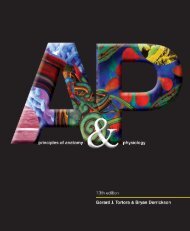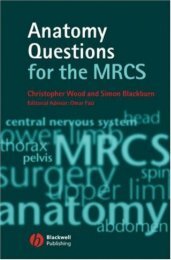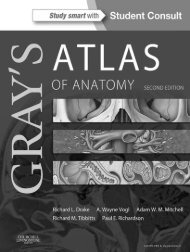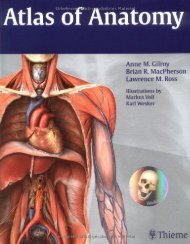urinalysis and body fluids
You also want an ePaper? Increase the reach of your titles
YUMPU automatically turns print PDFs into web optimized ePapers that Google loves.
©2008 F. A. Davis<br />
CHAPTER 2 • Renal Function 27<br />
29. Calculate the free water clearance from the following<br />
results:<br />
urine volume in 6 hours: 720 mL; urine osmolarity:<br />
225 mOsm; plasma osmolarity: 300 mOsm<br />
30. To provide an accurate measure of renal blood flow,<br />
a test substance should be completely:<br />
A. Filtered by the glomerulus<br />
B. Reabsorbed by the tubules<br />
C. Secreted when it reaches the distal convoluted<br />
tubule<br />
D. Cleared on each contact with functional renal tissue<br />
31. Given the following data, calculate the effective renal<br />
plasma flow:<br />
urine volume in 2 hours: 240 mL; urine PAH:<br />
150 mg/dL; plasma PAH: 0.5 mg/dL<br />
32. Renal tubular acidosis can be caused by the:<br />
A. Production of excessively acidic urine due to<br />
increased filtration of hydrogen ions<br />
B. Production of excessively acidic urine due to<br />
increased secretion of hydrogen ions<br />
C. Inability to produce an acidic urine due to<br />
impaired production of ammonia<br />
D. Inability to produce an acidic urine due to<br />
increased production of ammonia<br />
33. Tests performed to detect renal tubular acidosis after<br />
administering an ammonium chloride load include<br />
all of the following except:<br />
A. Urine ammonia<br />
B. Arterial pH<br />
C. Urine pH<br />
D. Titratable acicity<br />
Case Studies <strong>and</strong> Clinical Situations<br />
1. A 44-year-old man diagnosed with acute tubular<br />
necrosis has a blood urea nitrogen of 60 mg/dL <strong>and</strong> a<br />
blood glucose level of 100 mg/dL. A 2 urine glucose<br />
is also reported.<br />
a. State the renal threshold for glucose.<br />
b. What is the significance of the positive urine glucose<br />
<strong>and</strong> normal blood glucose?<br />
2. A patient develops a sudden drop in blood pressure.<br />
a. Diagram the reactions that take place to ensure<br />
adequate blood pressure within the nephrons.<br />
b. How do these reactions increase blood volume?<br />
c. When blood pressure returns to normal, how does<br />
the kidney respond?<br />
3. A physician would like to prescribe a nephrotoxic<br />
antibiotic for a 60-year-old man weighing 80 kg. The<br />
patient has a serum creatinine level of 1.0 mg/dL.<br />
a. How can the physician determine whether it is<br />
safe to prescribe this medication before the patient<br />
leaves the office?<br />
b. Can the medication be prescribed to this patient<br />
with a reasonable assurance of safety?<br />
c. A creatinine clearance was also run on the patient<br />
with the following results: serum creatinine,<br />
0.9 mg/dL; urine creatinine, 190 mg/dL; 24-hour<br />
urine volume, 720 mL. Should the patient<br />
continue to take the medication? Justify your<br />
answer.<br />
4. A laboratory is obtaining erratic serum osmolarity<br />
results on a patient who is being monitored at<br />
6 a.m., 12 p.m., 6 p.m., <strong>and</strong> 12 a.m. Osmolarities are<br />
not performed on the night shift; therefore, the midnight<br />
specimen is run at the same time as the 6 a.m.<br />
specimen.<br />
a. What two reasons could account for these discrepancies?<br />
b. If the laboratory is using a freezing point osmometer,<br />
would these discrepancies still occur? Why or<br />
why not?<br />
c. If a friend was secretly bringing the patient a pint<br />
of whiskey every night, would this affect the<br />
results? Explain your answer.<br />
5. Following overnight (6 p.m. to 8 a.m.) fluid deprivation,<br />
the urine-to-serum osmolarity ratio in a patient<br />
who is exhibiting polyuria <strong>and</strong> polydipsia is 1:1. The<br />
ratio remains the same when a second specimen is<br />
tested at 10 a.m. Vasopressin is then administered subcutaneously<br />
to the patient, <strong>and</strong> the fluid deprivation is<br />
continued until 2 p.m., when another specimen is<br />
tested.<br />
a. What disorder do these symptoms <strong>and</strong> initial laboratory<br />
results indicate?<br />
b. If the urine-to-serum osmolarity ratio on the 2 p.m.<br />
specimen is 3:1, what is the underlying cause of<br />
the patient’s disorder?<br />
c. If the urine-to-serum osmolarity ratio on the 2 p.m.<br />
specimen remains 1:1, what is the underlying cause<br />
of the patient’s disorder?

















